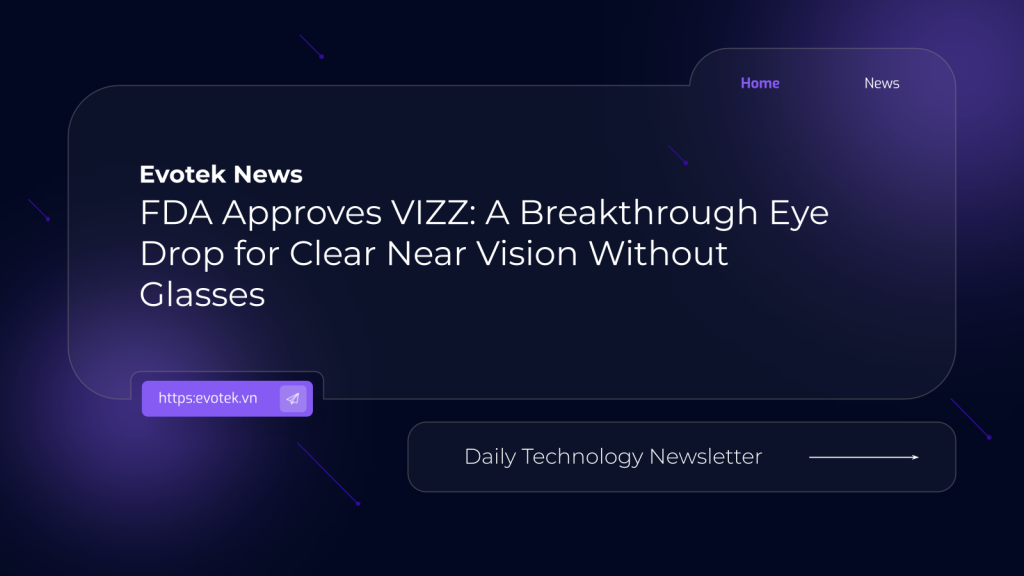The U.S. Food and Drug Administration (FDA) has given its approval to VIZZ, a groundbreaking aceclidine-based eye drop designed to significantly improve near vision in adults suffering from presbyopia. This condition, which leads to blurry near vision, affects over 100 million individuals in the United States alone. VIZZ, developed by pharmaceutical company LENZ, is set to become broadly available in the fourth quarter of 2025.
VIZZ represents a novel, once-daily ophthalmic solution that promises to restore clear near vision for up to 10 hours. This approval marks a pivotal moment for LENZ Therapeutics and is poised to revolutionize treatment options for the estimated 128 million American adults experiencing age-related blurry near vision.
How VIZZ Works: A Gentle & Effective Approach
Unlike older solutions, VIZZ utilizes aceclidine to gently reduce the size of the eye’s pupil. This action creates a “pinhole effect,” similar to adjusting a camera lens aperture, which brings nearby objects into sharper focus. A key advantage of VIZZ is its unique mechanism: it achieves this improved focus without significantly impacting the eye’s focusing muscles, thus avoiding blurred distance vision or the “zoomed-in” (myopic shift) effect often associated with other treatments.
This innovative approach means users can experience improved reading vision for extended periods, free from the need for glasses and without the unwanted side effects of previous generations of eye drops.
VIZZ vs. Previous Treatments: A Class Apart
While the first eye drops for presbyopia were introduced in 2021, VIZZ distinguishes itself as a “first-in-class” treatment. Earlier drops, such as Vuity (pilocarpine hydrochloride 1.25%), improved near vision but carried potential side effects like brow heaviness or rare vitreoretinal issues, primarily due to their activation of the ciliary muscle.
VIZZ, containing aceclidine, is a pupil-selective miotic that works without substantially stimulating the ciliary (focusing) muscle. This crucial difference allows it to create the beneficial pinhole effect, enhancing near vision without the adverse outcomes sometimes seen with other treatments. According to Dr. Marc Bloomenstein, a VIZZ clinical investigator, this FDA approval signifies a “disruptive paradigm shift” in presbyopia treatment, offering a highly effective and sought-after solution that could swiftly become the new standard of care.
Robust Clinical Data Supports Approval
The FDA’s decision is underpinned by comprehensive data from three randomized, double-masked, controlled Phase II studies involving hundreds of participants. Across more than 30,000 treatment days, VIZZ demonstrated excellent tolerability, with no serious adverse events reported. This strong safety profile reinforces its potential as a preferred treatment option.
Understanding Presbyopia: The Inevitable Age-Related Vision Change
Presbyopia is an unavoidable condition linked to aging, affecting nearly everyone over the age of 45. It manifests as a gradual loss of near-sight vision, progressively worsening and typically necessitating corrective lenses like reading glasses or contact lenses. While its progression can be gradual, it sometimes accelerates unexpectedly, making everyday tasks such as reading instructions or food labels increasingly challenging.
LENZ Therapeutics emphasizes that VIZZ is “uniquely engineered, highly-differentiated and designed to deliver quick onset and lasting benefit for the vast majority of presbyopes.” They assert its position not just as “best-in-class,” but as the “only in a class of pupil selective ciliary-sparing myotics.”
It is important to note that while the FDA approval is based on submitted trial data, peer-reviewed scientific publications typically follow regulatory approvals rather than preceding them, a common practice in the fields of ophthalmology and dermatology. Further details and guidance from the FDA are publicly available.

 日本語
日本語 한국어
한국어 Tiếng Việt
Tiếng Việt 简体中文
简体中文